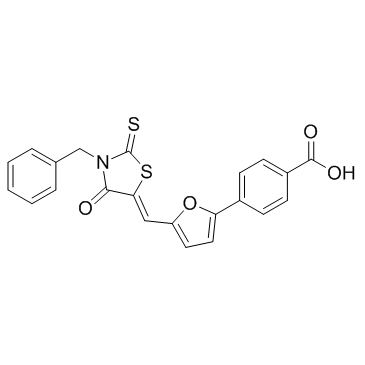344897-95-6
| Name | 4-{5-[(Z)-(3-Benzyl-4-oxo-2-thioxo-1,3-thiazolidin-5-ylidene)methyl]-2-furyl}benzoic acid |
|---|---|
| Synonyms |
4-{5-[(Z)-(3-Benzyl-4-oxo-2-thioxo-1,3-thiazolidin-5-ylidene)methyl]-2-furyl}benzoic acid
MFCD01151276 Benzoic acid, 4-[5-[(Z)-[4-oxo-3-(phenylmethyl)-2-thioxo-5-thiazolidinylidene]methyl]-2-furanyl]- Leukadherin-1 |
| Description | Leukadherin-1 is a specific agonist of CR3 and the leukocyte surface integrin CD11b/CD18. |
|---|---|
| Related Catalog | |
| In Vitro | Leukadherin-1 (LA1) modulates natural killer (NK) cell inflammatory cytokine secretion. The SLE-associated CD11b-R77H variant does not influence NK cell response to Leukadherin-1. Leukadherin-1 does not modulate Syk activation in NK cells. Leukadherin-1 (LA1) does not modulate signal transducer and activator of transcription (STAT)-4 phosphorylation. Leukadherin-1 modulates TLR-2 and TLR-7/8-induced monocyte cytokine secretion[1]. |
| In Vivo | Leukadherin-1 decreases macrophage infiltration in the lungs during hyperoxia. Furthermore, treatment with Leukadherin-1 improves alveolarization and angiogenesis and decreases pulmonary vascular remodeling and PH. Targeting leukocyte trafficking using Leukadherin-1, an integrin agonist, is beneficial in preventing lung inflammation and protecting alveolar and vascular structures during hyperoxia[2]. |
| Cell Assay | Supernatant cytokines are quantified after stimulation and culture for 18 h (monocytes) or 24 h (NK cells). Except for bead-based stimulation, all experiments are conducted using 100 µL cells in a 96-well plate format. NK cell stimuli are added as follows: (1) Syk inhibitor (1 μM), (2) Leukadherin-1 or dimethylsulphoxide (DMSO) (vector control) (7.5 μM). Shown to induce∼82% of maximum response with negligible off-target effect, (3) anti-CD210 or isotype control (5 µg/mL), (4) 30-45 min after Leukadherin-1 NK cells are stimulated with combinations of IL-12 (10 ng/mL), IL-15 (30 ng/mL) or IL-18 (10 ng/mL): either IL-12 + IL-15 or IL-12 + IL-18. Monocytes are stimulated using pam3csk4 (TLR-2 agonist, 300 ng/mL) or R848 (TLR-7/8 agonist, 2 µg/mL). Supernatants are stored at −80ºC for < 1 month before quantification. To exclude non-specific Leukadherin-1-mediated cytotoxicity, the cell viability is assayed at 24 h using the CellTitre-Glo reagent. No significant loss of viability in comparison with the DMSO control is seen, concurring with published data in other cell types. |
| References |
| Density | 1.5±0.1 g/cm3 |
|---|---|
| Boiling Point | 634.7±65.0 °C at 760 mmHg |
| Molecular Formula | C22H15NO4S2 |
| Molecular Weight | 421.489 |
| Flash Point | 337.6±34.3 °C |
| Exact Mass | 421.044250 |
| LogP | 4.88 |
| Vapour Pressure | 0.0±2.0 mmHg at 25°C |
| Index of Refraction | 1.756 |
| Storage condition | -20℃ |
| RIDADR | NONH for all modes of transport |
|---|
